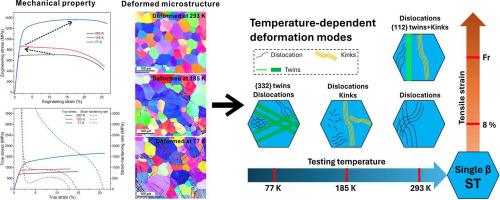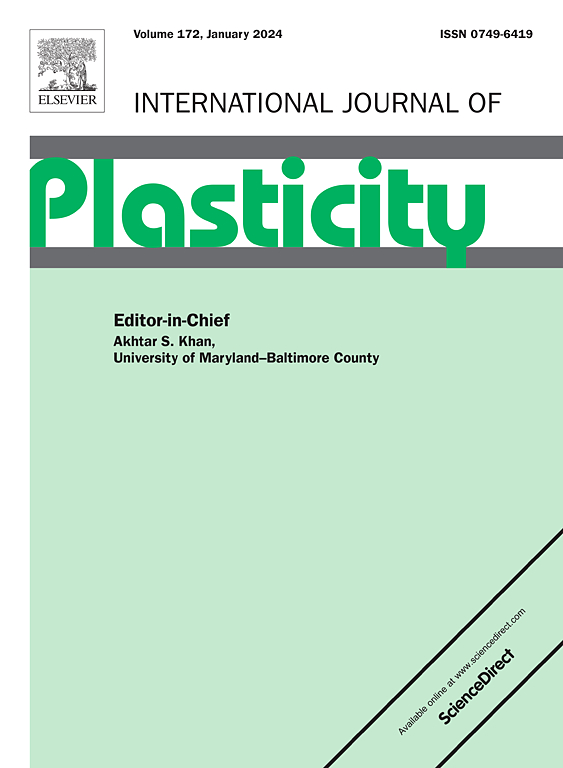Unique transitions in uniform elongation and deformation mechanisms of a refractory medium-entropy alloy at cryogenic temperatures
IF 9.4
1区 材料科学
Q1 ENGINEERING, MECHANICAL
引用次数: 0
Abstract
Refractory high-entropy alloys (RHEAs) and medium-entropy alloys (RMEAs) are potential candidates for high-temperature applications; dislocations play crucial roles in the plastic deformation of these alloys at both room and elevated temperatures. However, there is a significant deficiency in the understanding of their temperature-dependent microstructure-mechanical property correlations at low temperatures, which is crucial for evaluating their performance and ensuring service safety under variable-temperature extreme conditions. This study investigated the mechanical properties and deformation mechanisms of a non-equiatomic Ti48.9Zr32.0Nb12.6Ta6.5 RMEA at ambient and cryogenic temperatures. Tensile testing revealed intriguing temperature-dependent behaviors: as the temperature decreased, yield strength increased, while uniform elongation (UE) followed an abnormal U-shaped trend. The RMEA exhibited good UE at 293 K (10.9 %), but UE dropped sharply to 185 K (2.2 %). However, UE peaked at 77 K (17.2 %) along with the highest ultimate tensile strength. These indicated a transition in the deformation mechanisms. Microstructural analysis showed that considerable strain hardening at 293 K was owing to abundant dislocation interactions as well as {112}<111> twins. At 185 K, strain hardening weakened due to suppressed dislocation activity, whereas kinking prevented the ductile-to-brittle transition despite limited UE. The strong strain hardening and enhanced UE at 77 K were attributed to the twinning-induced plasticity effect from {332}<113> deformation twins. In conclusion, this study highlights the anomalous temperature-dependent mechanical behavior of this RMEA and the corresponding evolution of deformation mechanisms. The findings provide key insights into the alloy design and optimizing the performance of RHEAs/RMEAs for applications in cryogenic and variable-temperature environments.


低温下难熔中熵合金均匀伸长率和变形机制的独特转变
耐火高熵合金(RHEAs)和中熵合金(rmea)是高温应用的潜在候选者;在室温和高温下,位错对这些合金的塑性变形起着至关重要的作用。然而,在低温下,对其温度依赖的微观结构-力学性能相关性的理解存在明显不足,这对于评估其性能和确保在变温条件下的使用安全至关重要。研究了非等原子Ti48.9Zr32.0Nb12.6Ta6.5 RMEA在常温和低温下的力学性能和变形机理。拉伸试验揭示了有趣的温度依赖行为:随着温度的降低,屈服强度增加,而均匀伸长率(UE)呈异常的u型趋势。RMEA在293 K时具有良好的UE(10.9%),但UE急剧下降至185 K(2.2%)。然而,UE在77 K时达到峰值(17.2%),极限抗拉强度也达到最高。这表明变形机制发生了转变。显微组织分析表明,在293 K时,大量的位错相互作用和{112}<;111>;双胞胎。在185 K时,由于位错活性受到抑制,应变硬化减弱,而扭结阻止了韧脆性转变,尽管UE有限。{332}<113>;变形双胞胎。总之,本研究强调了该RMEA的异常温度依赖力学行为和相应的变形机制演变。这些发现为低温和变温环境下的合金设计和优化RHEAs/ rmea性能提供了关键见解。
本文章由计算机程序翻译,如有差异,请以英文原文为准。
求助全文
约1分钟内获得全文
求助全文
来源期刊

International Journal of Plasticity
工程技术-材料科学:综合
CiteScore
15.30
自引率
26.50%
发文量
256
审稿时长
46 days
期刊介绍:
International Journal of Plasticity aims to present original research encompassing all facets of plastic deformation, damage, and fracture behavior in both isotropic and anisotropic solids. This includes exploring the thermodynamics of plasticity and fracture, continuum theory, and macroscopic as well as microscopic phenomena.
Topics of interest span the plastic behavior of single crystals and polycrystalline metals, ceramics, rocks, soils, composites, nanocrystalline and microelectronics materials, shape memory alloys, ferroelectric ceramics, thin films, and polymers. Additionally, the journal covers plasticity aspects of failure and fracture mechanics. Contributions involving significant experimental, numerical, or theoretical advancements that enhance the understanding of the plastic behavior of solids are particularly valued. Papers addressing the modeling of finite nonlinear elastic deformation, bearing similarities to the modeling of plastic deformation, are also welcomed.
 求助内容:
求助内容: 应助结果提醒方式:
应助结果提醒方式:


